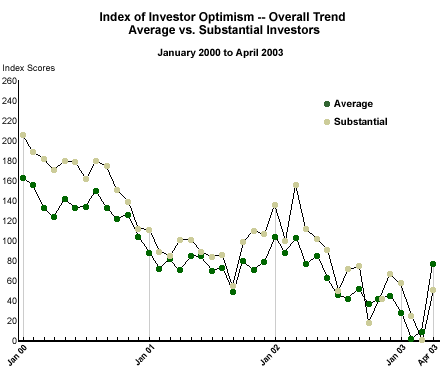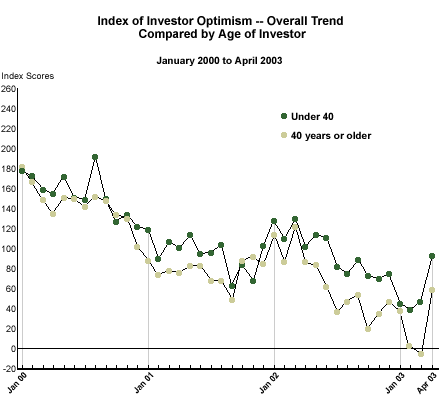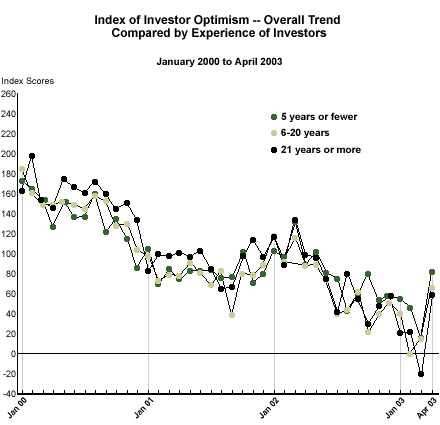Tomorrow, Fed Chairman Alan Greenspan will testify before the House about his view of the post-war economy. Six days later, the Federal Open Market Committee (FOMC) will meet to discuss interest rate policy. It is widely expected that Greenspan will argue that the removal of war-related uncertainties has set the stage for an economic recovery. In turn, this position is likely to lead the FOMC to leave interest rates unchanged.
If Greenspan is seeking support for his position, he need look no farther than the April surge in investor optimism. In April, the Index of Investor Optimism -- a joint effort of UBS and The Gallup Organization -- saw its biggest increase since its inception in 1996. Both the Personal and Economic Dimensions rose by record amounts. Clearly, the removal of war uncertainties has made investors considerably more optimistic about both their own personal situations and the outlook for the U.S. economy in the months ahead.
However, a more detailed look at investor optimism shows that while optimism soared among all types of investors during April, some groups of investors are significantly more optimistic than others. And, this is something the FOMC may want to consider as it discusses interest rates.
Investor Optimism Soars in April
The Index of Investor Optimism surged 61 points in April and now stands at 66. During the first half of March and prior to the invasion of Iraq, investor confidence had fallen to a new six-year low of 5. The record April surge in the Index brings it close to its June 2002 level of 72. And, the data suggest that investor optimism increased not only during the early days of April but also continued to do so following the fall of Baghdad on April 9. Even more significantly, U.S. investor optimism is significantly higher now than it was just prior to the war among all key investor groups.
Optimism Surged Among Both Substantial and Average Investors . . .
Among substantial investors -- those with $100,000 or more of investable assets -- the Index increased 50 points from zero in March to 50 in April. This returns substantial investor optimism to near its January level. On the other hand, that figure is still at less than half the level it was a year ago (111).
At the same time, the Index among other -- average -- investors increased 68 points to 76. This puts average investor optimism at its highest level since last May (84) and at the same level as a year ago (76).

. . . As Did Optimism Among Older and Younger Investors . . .
The Index of Investor Optimism among older investors -- those aged 40 and older -- increased 64 points reaching 58 in April 2003. This is the highest level seen among older investors since June 2002 (61) and still considerably below where it was a year ago (86).
Among younger investors, the Index increased 46 points and now stands at 92. This puts younger investor optimism at its highest level since last June (110). Younger investor optimism stood at 101 a year ago.

. . . And Optimism Among New and Experienced Investors
Among new investors -- those with five or fewer years of investing experience -- the Index of Investor Optimism increased from 15 in March to 81 in April 2003. That 66-point increase returns new investor optimism to its June 2002 level (80). However, new investor optimism is still below its May 2002 level (101) and where it was a year ago (88).
Among those investors with 6 to 20 years of investing experience, overall optimism increased 51 points in April. This is the highest level for these investors since June 2002 when their Index was at 73. A year ago, optimism among these investors stood at 87.
Finally, among the most experienced investors -- those with 21 years or more of investing experience -- the Index increased 79 points to 58. This puts investor optimism among the most experienced investors at the same level as in December 2002 (57) and at about half its level of a year ago (98).

Bottom Line
Obviously, the April surge in investor optimism among investors of all types is good news for the economic outlook. It also supports Greenspan's argument that war uncertainties have been casting a pall over the U.S. economy. However, this does not necessarily mean that the economy is poised for a "real" recovery.
In this regard, it should be noted that it is average-level investors, younger investors, and the least experienced investors who are most optimistic right now. Among those groups whose optimism tends to be most predictive of future economic activity -- substantial investors, older investors, and more experienced investors -- optimism did rise, but they remain less optimistic than the former groups.
These differences in investor optimism should be understood as the FOMC considers the future of interest rates. Right now, several key investor groups do not seem convinced that success in Iraq will lead to economic recovery in the immediate-term. Another reduction in interest rates, however, may go a long way in building additional optimism among these investors and the consuming public.
*Results are based on telephone interviews with 1,004 investors, aged 18 and older, conducted April 1-16, 2003. For results based on the total sample of investors, one can say with 95% confidence that the margin of sampling error is ±3%.
